When Are Security Cameras Needed At A Business
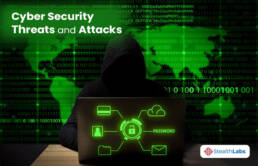
Cyber Security Threats and Attacks: All Y'all Need to Know
Corporate Espionage, Business Disruption, or Fiscal Gain. Any the motivation, cybersecurity threats have become pervasive and continue to upend every facet of the digital realm.
Co-ordinate to Verizon'due south 2020 Information Breach Investigations Report (DBIR), 86% of cybersecurity breaches were financially motivated, and x% were motivated by espionage.
Beyond causing severe financial impairment, cyberattacks tin pb to regulatory penalties, lawsuits, reputational impairment, and business continuity disruptions.
No business and Information technology organization are safe in the present cyber world. Equally cybercriminals increasingly rely on sophisticated technologies, organizations often feel hopeless as their confidential data and critical assets fall prey to malicious attacks.
Moreover, the rapid adoption of emerging technologies, including AI, the Internet of Things (IoT), and cloud computing, have added new cyber threats for organizations while adding complexity to existing risks.
What is a Threat in Cybersecurity?
A cybersecurity threat is a malicious and deliberate attack past an individual or organization to gain unauthorized access to another individual'southward or organization's network to damage, disrupt, or steal Information technology assets, computer networks, intellectual property, or any other form of sensitive information.
Types of Cybersecurity Threats
While the types of cyber threats keep to grow, there are some of the most mutual and prevalent cyberthreats that present-mean solar day organizations need to know. Top 10 cyber security threats are as follow:
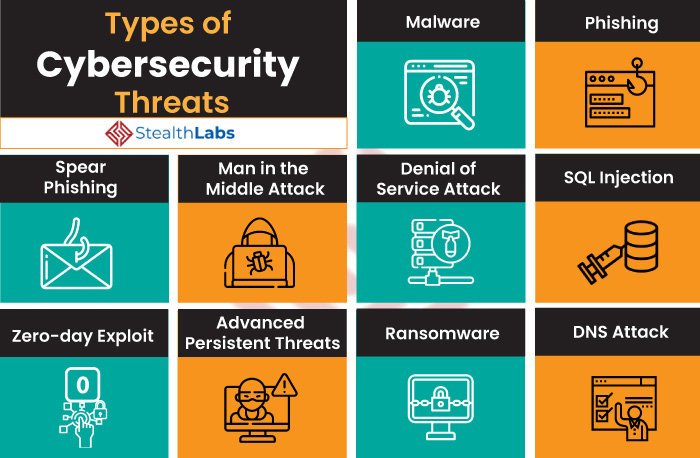
i) Malware
Malware attacks are the well-nigh common cyber security threats. Malware is defined as malicious software, including spyware, ransomware, viruses, and worms, which gets installed into the organisation when the user clicks a dangerous link or email. In one case inside the system, malware can cake access to critical components of the network, damage the system, and assemble confidential data, among others.
According to Accenture, the average cost of a malware attack is USD 2.6 1000000.
two) Phishing
Cybercriminals send malicious emails that seem to come from legitimate resources. The user is so tricked into clicking the malicious link in the email, leading to malware installation or disclosure of sensitive information like credit card details and login credentials.
Phishing assail accounts for over 80% of reported cyber incidents.
3) Spear Phishing
Spear phishing is a more than sophisticated class of a phishing attack in which cybercriminals target only privileged users such as organisation administrators and C-suite executives.
More than 71% of targeted attacks involve the employ of spear phishing.
four) Man in the Middle Set on
Man in the Middle (MitM) set on occurs when cyber criminals place themselves between a ii-party communication. One time the attacker interprets the advice, they may filter and steal sensitive information and return different responses to the user.
According to Netcraft, 95% of HTTPS servers are vulnerable to MitM.
5) Denial of Service Set on
Denial of Service attacks aims at flooding systems, networks, or servers with massive traffic, thereby making the arrangement unable to fulfill legitimate requests. Attacks can also use several infected devices to launch an attack on the target system. This is known as a Distributed Denial of Service (DDoS) assault.
The twelvemonth 2019 saw a staggering viii.4 million DDoS attacks.
vi) SQL Injection
A Structured Query Linguistic communication (SQL) injection assail occurs when cybercriminals effort to admission the database by uploading malicious SQL scripts. One time successful, the malicious actor can view, alter, or delete data stored in the SQL database.
SQL injection accounts for almost 65.1% of all web application attacks.
7) Cipher-mean solar day Exploit
A null-twenty-four hour period attack occurs when software or hardware vulnerability is announced, and the cybercriminals exploit the vulnerability earlier a patch or solution is implemented.
It is predicted that zero-solar day attacks will rise to ane per day past 2021.
8) Advanced Persistent Threats (APT)
An advanced persistent threat occurs when a malicious player gains unauthorized admission to a organization or network and remains undetected for an extended time.
45% of organizations experience that they are likely to be the target of an APT.
9) Ransomware
Ransomware is a type of malware set on in which the assailant locks or encrypts the victim's information and threatens to publish or blocks admission to data unless a ransom is paid. Learning more than about ransomware threats can assist companies foreclose and cope with them better.
Ransomware attacks are estimated to cost global organizations USD 20 billion by 2021.
x) DNS Attack
A DNS attack is a cyberattack in which cybercriminals exploit vulnerabilities in the Domain Proper name System (DNS). The attackers leverage the DNS vulnerabilities to divert site visitors to malicious pages (DNS Hijacking) and remove data from compromised systems (DNS Tunneling).
The average toll of a DNS attack stood at USD 924,000 in 2020.
Cyber Threat Actors
In club to respond effectively to a cyberattack, it'south imperative to know the threat actors and understand their tactics, techniques, and procedures.
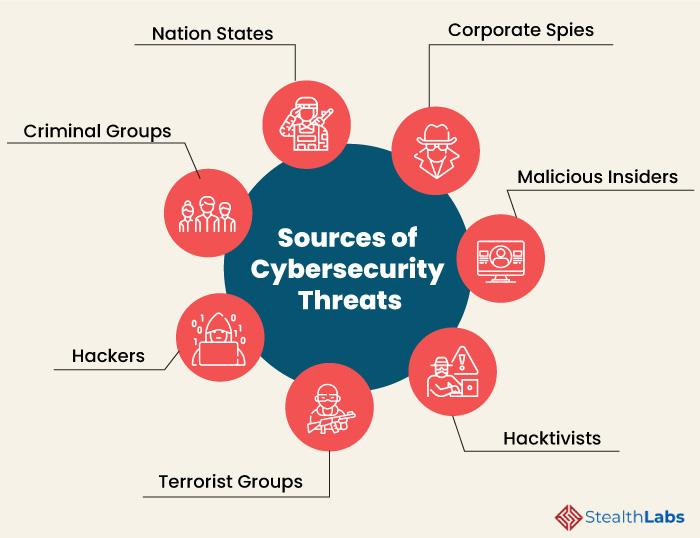
Here are some of the common sources of cyber threats:
ane) Nation States
Cyber attacks past a nation can inflict detrimental impact by disrupting communications, armed forces activities and everyday life.
2) Criminal Groups
Criminal groups aim to infiltrate systems or networks for financial gain. These groups use phishing, spam, spyware, and malware to conduct identity theft, online fraud, and arrangement extortion.
iii) Hackers
Hackers explore diverse cyber techniques to breach defenses and exploit vulnerabilities in a computer organization or network. They are motivated by personal proceeds, revenge, stalking, fiscal proceeds, and political activism. Hackers develop new types of threats for the thrill of challenge or bragging rights in the hacker customs.
iv) Terrorist Groups
Terrorists conduct cyber attacks to destroy, infiltrate, or exploit critical infrastructure to threaten national security, compromise military equipment, disrupt the economy, and cause mass casualties.
5) Hacktivists
Hacktivists carry out cyberattacks in support of political causes rather than financial gain. They target industries, organizations, or individuals who don't align with their political ideas and agenda.
6) Malicious Insiders
97% of surveyed Information technology leaders expressed concerns almost insider threats in cyber security. Insiders tin include employees, 3rd-party vendors, contractors, or other concern associates who have legitimate access to enterprise assets but misuse that accesses to steal or destroy data for fiscal or personal gain.
seven) Corporate Spies
Corporate spies conduct industrial or business espionage to either brand a profit or disrupt a competitor's business past attacking critical infrastructure, stealing trade secrets, and gaining admission.
Acme Cyber Threat Facts, Figures, and Statistics
Cyber threats continue to evolve, causing trillions worth of losses to the cyber world. Hither are some alarming facts, figures, and statistics on the latest cybersecurity threats:
- The global average cost of a data alienation is USD 3.92 million
- Estimated almanac losses through cyberattacks to reach USD 6 Trillion by 2021
- Cybercrime breaches to increase by 76% by 2024
- Over fifty% of all global data breaches to occur in the U.s.a. by 2023
- The average cost of a data breach to a US company is USD 7.91 million
- The average number of days to identify an incident in 2019 was 206 days
- ii billion records were exposed due to information breaches in the outset half of 2019
- A concern will autumn victim to a ransomware set on every 11 seconds in 2021
- Cyberattacks on IoT devices increased by 300% in 2019
- Cyberthreat complaints increased by 400% in the United states amidst the coronavirus pandemic
Emerging Cyber Threats in 2021 and Across
The coronavirus pandemic emerged as the biggest challenge for businesses and IT organizations in 2020. Amid the pandemic, the cyber threats and information breaches have grown in composure and volume, with the number of breaches increasing 273% in the first quarter, compared to 2019. According to Microsoft, the pandemic-related phishing and social engineering attacks have skyrocketed to 30,000 per day in the US alone.
What should we expect in 2021?
Here are some of the emerging cybersecurity threats that will dominate the cybersecurity landscape in 2021 and across:
1) Pandemic-related Attacks
The cybercriminals will go along to leverage the coronavirus pandemic and related topics every bit themes for their phishing and social applied science campaigns. Their attacks oft coincide with significant events, such as a sudden surge in COVID-xix cases or the announcement of a new vaccine. The threat actors lure users into clicking a malicious link or attachment bearded as legitimate COVID-19 related topics.
two) Ransomware Attacks
According to Cybersecurity Ventures, businesses will fall victim to a ransomware assault every 11 seconds in 2021, downward from every xiv seconds in 2019. The estimated cost of ransomware, including the toll to restore and mitigate following an attack, will cross USD 20 billion in 2021.
3) Cloud Breaches
As more companies drift to the cloud to facilitate remote working and ensure business organisation continuity, cybercriminals are following the same tendency and targeting the cloud more frequently. Cloud-based security risks, including deject misconfigurations, incomplete information deletion, and vulnerable cloud-apps, will exist the common sources of cyberattacks.
4) Mobile Security Threats
In a bid to ensure business continuity amid the pandemic, almost all businesses initiated piece of work from home facility. Employees working remotely utilize devices such as smartphones and tablets that are not properly secured, patched, and managed by the IT security section. Unfortunately, they bring some unique IT security threats and vulnerabilities, putting the organization at the risk of cyber attack.
5) IoT Attacks
Global organizations are increasingly deploying IoT devices and applications to accelerate operations, capture more data, remotely manage infrastructure, better customer service, and more.

All the same, many IoT devices often lack robust security features, putting them at gamble of cyberattack. Cybercriminals can leverage the IoT vulnerabilities to proceeds command of devices for utilise in botnets and penetrate the network.
Also Read: Cyber Attacks and Data Breaches in 2020
As cybercriminals continue to adopt new technologies and attack strategies, organizations must suit their approach to cybersecurity. Below are some cybersecurity best practices that help your system prepare against cyber threats and ensure business continuity:
Cybersecurity All-time Practices to Protect from Cyber Threats
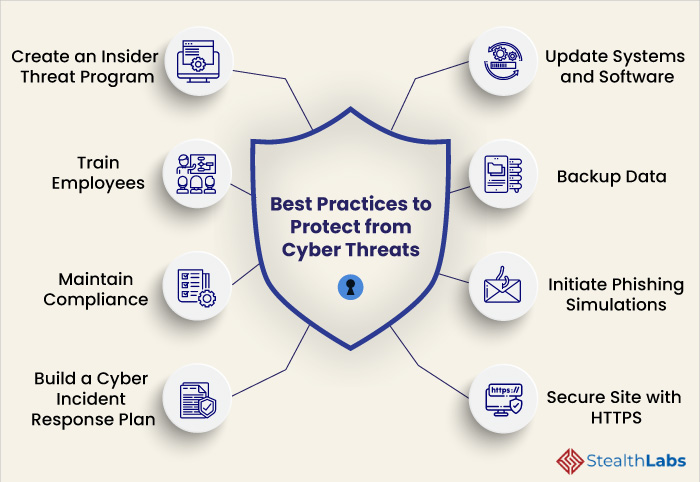
1) Create an Insider Threat Program
Creating an insider threat programme is imperative for organizations to forbid employees from misusing their access privileges to steal or destroy corporate data. The IT security team should not delay and gain the approving of top direction to deploy policies across departments.
2) Train employees
Employees are the first line of defense confronting cyberthreats for every organization. Thus, organizations must conduct comprehensive cybersecurity awareness programs to train employees on recognizing and responding to cyber threats. This dramatically improves an system'south security posture and cyber resilience.
three) Maintain Compliance
Irrespective of the level of cybersecurity an organization implements, it must ever maintain compliance with data regulations that apply to their industry and geographical location. The organization must stay informed with the evolving compliance regulations to leverage its benefits.
four) Build a Cyber Incident Response Plan
In the nowadays digital era, no arrangement is exempt from cyberattacks. Thus, organizations of all sizes must build an effective Cyber Security Incident Response Plan (CSIRP) to navigate cyber adversaries. It enables businesses to gear up for the inevitable, reply to emerging threats, and recover quickly from an set on.
v) Regularly Update Systems and Software
As cyber threats are evolving speedily, your optimized security network can go outdated inside no time, putting your organization at the risk of cyberattack. Therefore, regularly update the security network and the associated systems and software.
6) Fill-in Information
Backing upwardly information regularly helps reduce the risk of data breaches. Backup your website, applications, databases, emails, attachments, files, calendars, and more on an ongoing and consistent ground.
7) Initiate Phishing Simulations
Organizations must behave phishing simulations to educate employees on how to avert clicking malicious links or downloading attachments. It helps employees understand the far-reaching furnishings of a phishing assail on an organisation.
8) Secure Site with HTTPS
Organizations must encrypt and secure their website with an SSL (Secure Sockets Layer) certificate. HTTPS protects the integrity and confidentiality of data between the user and the website.
In Conclusion:
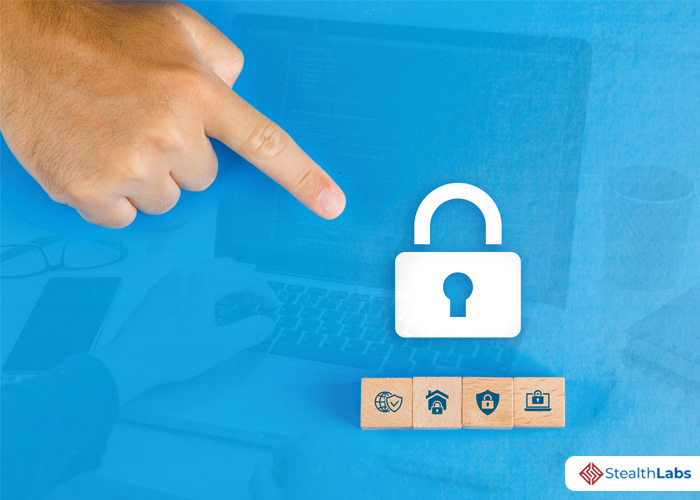
As reliance on digital technologies continues to increase, cyber attacks accept become likewise sophisticated. Thus, organizations that rely on outmoded cybersecurity strategies leave themselves vulnerable to a potential cyberattack.
To preclude these threats, organizations must refine their cybersecurity program. An effective cybersecurity programme tin help organizations disrupt attacks as they occur, reduce recovery time, and incorporate future threats.
No affair what the level of your cybersecurity maturity, StealthLabs can assist you fortify your security stance. With a flexible, applied, and proactive approach to cybersecurity, nosotros can help you navigate the constantly evolving threat landscape.
Contact Us
More Cyber Security Articles:
- Cyber Attacks and Data Breaches in 2020
- Infographic: Why Businesses Demand Cyber Security Compliance?
- Top 10 Cyber Security Tips for Black Friday and Cyber Mon!
- Automotive Cyber Security Market To Accomplish USD five.77 Bn By 2025!
- Summit Cybersecurity Trends in 2021
- Cybersecurity Solution Providers in U.s.
Source: https://www.stealthlabs.com/blog/cyber-security-threats-all-you-need-to-know/
Posted by: weekslontoll.blogspot.com


0 Response to "When Are Security Cameras Needed At A Business"
Post a Comment